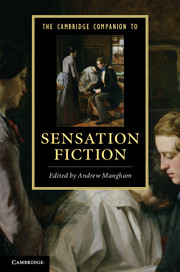
- Publisher:
- Cambridge University Press
- Online publication date:
- November 2013
- Print publication year:
- 2013
- Online ISBN:
- 9780511675744
- Collection:
- Cambridge Companions to Literature and Classics

In 1859 the popular novelist Wilkie Collins wrote of a ghostly woman, dressed from head to toe in white garments, laying her cold, thin hand on the shoulder of a young man as he walked home late one evening. His novel The Woman in White became hugely successful and popularised a style of writing that came to be known as sensation fiction. This Companion highlights the energy, the impact and the inventiveness of the novels that were written in 'sensational' style, including the work of Mary Elizabeth Braddon, Mrs Henry Wood and Florence Marryat. It contains fifteen specially-commissioned essays and includes a chronology and a guide to further reading. Accessible yet rigorous, this Companion questions what influenced the shape and texture of the sensation novel, and what its repercussions were both in the nineteenth century and up to the present day.
'… a highly refreshing study of the sensation fiction genre … [a] well-researched and highly recommended introduction to sensation fiction.'
Source: The Gothic Imagination
‘… [the] contributions are rigorously researched, thoughtful and beautifully written.’
J. Greg Matthews Source: Reference Reviews
'Accessible yet rigorous, this Companion features thought-provoking and well documented essays by sixteen scholars who have written extensively about Sensation from a variety of critical and literary perspectives, demonstrating what influenced the shape and texture of the sensation novel, and establishing its repercussions textually as well as in stage and media adaptations.'
Philip V. Allingham Source: Notes and Queries
'Quite effectively, the essays Mangham has commissioned represent the range and variety of approaches that sensation inspires, very few of which place authors and their works at the center. This Companion surely creates for students (and their teachers) the opportunity to understand sensation as a wide-ranging and ongoing phenomenon, in which the representation of 'the mysteries which are at our own doors,' in James's famous phrase, could make strange even the most banal facets of everyday life …'
Mary Jean Corbett Source: Victorian Studies
 Loading metrics...
Loading metrics...
* Views captured on Cambridge Core between #date#. This data will be updated every 24 hours.
Usage data cannot currently be displayed.